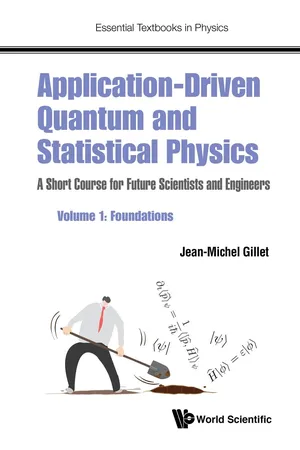
Application-Driven Quantum and Statistical Physics
A Short Course for Future Scientists and Engineers - Volume 1: Foundations
- 300 pages
- English
- ePUB (mobile friendly)
- Available on iOS & Android
Application-Driven Quantum and Statistical Physics
A Short Course for Future Scientists and Engineers - Volume 1: Foundations
About this book
Bridging the gap between traditional books on quantum and statistical physics, this series is an ideal introductory course for students who are looking for an alternative approach to the traditional academic treatment.
This pedagogical approach relies heavily on scientific or technological applications from a wide range of fields. For every new concept introduced, an application is given to connect the theoretical results to a real-life situation. Each volume features in-text exercises and detailed solutions, with easy-to-understand applications.
This first volume sets the scene of a new physics. It explains where quantum mechanics come from, its connection to classical physics and why it was needed at the beginning of the twentieth century. It examines how very simple models can explain a variety of applications such as quantum wells, thermoluminescence dating, scanning tunnel microscopes, quantum cryptography, masers, and how fluorescence can unveil the past of art pieces.
Contents:
- Experimental Puzzles and Birth of a New Constant in Physics:
- From Waves to Particles
- From Particles to Wave Fields
- From Phenomenology to an Axiomatic Formulation of Quantum Physics:
- A Heuristic Approach to Quantum Modelling
- Piecewise Constant Potentials
- Quantum Postulates and Their Mathematical Artillery
- A Classical to Quantum World Fuzzy Border:
- Phase Space Classical Mechanics
- Quantum Criteria (Who Needs Quantum Physics?)
Readership: Undergraduate students who need a concise introduction to quantum and statistical physics. Graduate students who want to return and learn about the subject from a different perspective.
Key Features:
- Conciseness
- Emphasis on easy-to-understand applications
- Exercises in the text with detailed solutions
- Focus on applicable concepts (very little physics for its own sake)
- Detailed index
- Additional explanations on essential points which (over the years) have proved to be a recurrent difficulty for the student
Frequently asked questions
- Essential is ideal for learners and professionals who enjoy exploring a wide range of subjects. Access the Essential Library with 800,000+ trusted titles and best-sellers across business, personal growth, and the humanities. Includes unlimited reading time and Standard Read Aloud voice.
- Complete: Perfect for advanced learners and researchers needing full, unrestricted access. Unlock 1.4M+ books across hundreds of subjects, including academic and specialized titles. The Complete Plan also includes advanced features like Premium Read Aloud and Research Assistant.
Please note we cannot support devices running on iOS 13 and Android 7 or earlier. Learn more about using the app.
Information
Part I
Experimental Puzzles and Birth of a New Constant in Physics
1
From Waves to Particles

1.1.Short Wavelength Issue in Black-Body Radiation





Table of contents
- Cover
- Halftitle
- Title
- Copyright
- Preface
- About the Author
- Contents
- Part I Experimental Puzzles and Birth of a New Constant in Physics
- Part II From Phenomenology to an Axiomatic Formulation of Quantum Physics
- Part III A Classical to Quantum World Fuzzy Border
- Bibliography
- Index